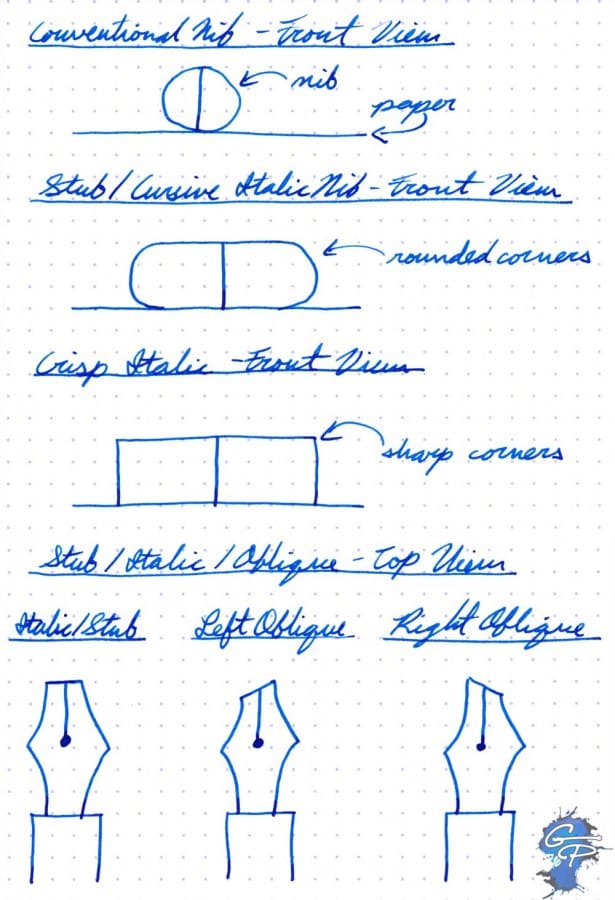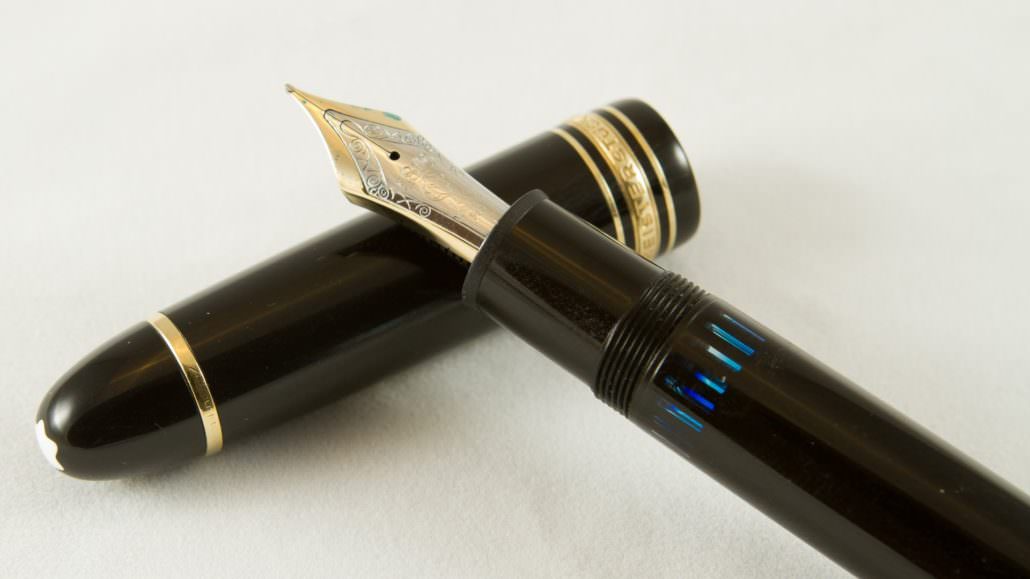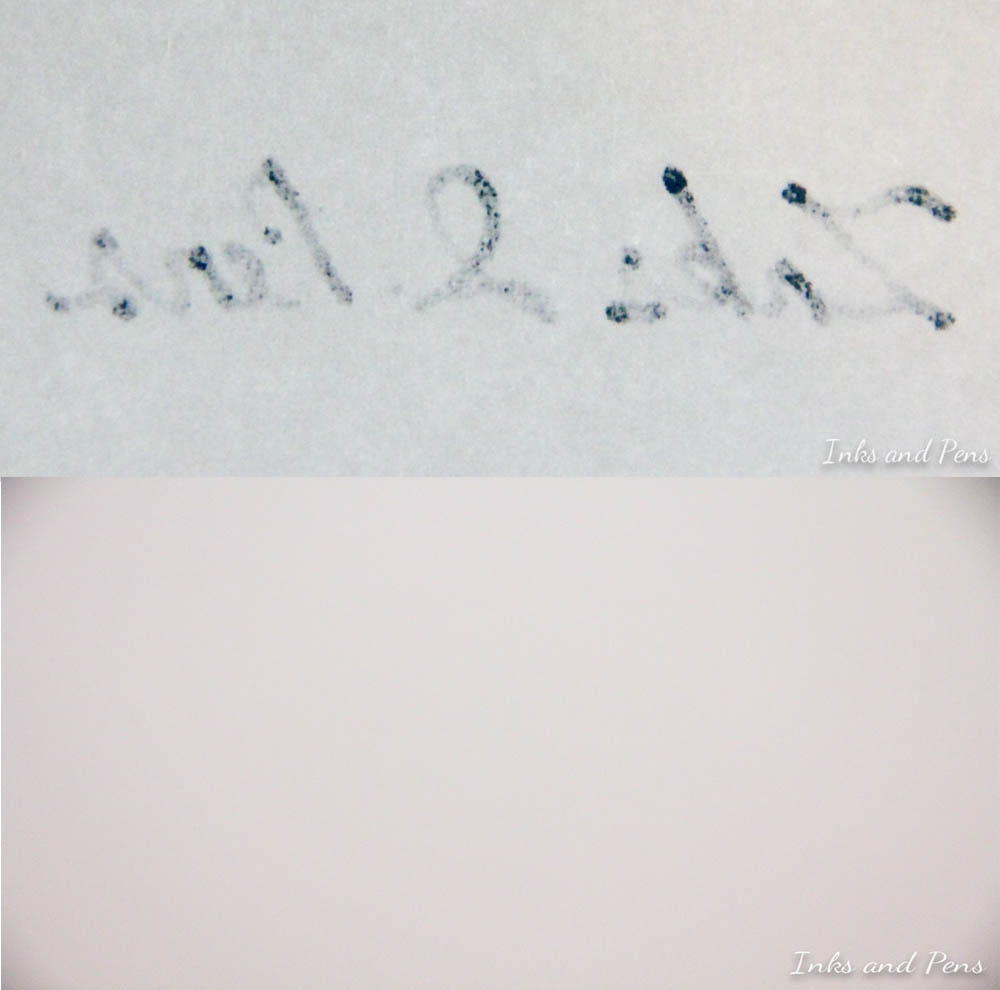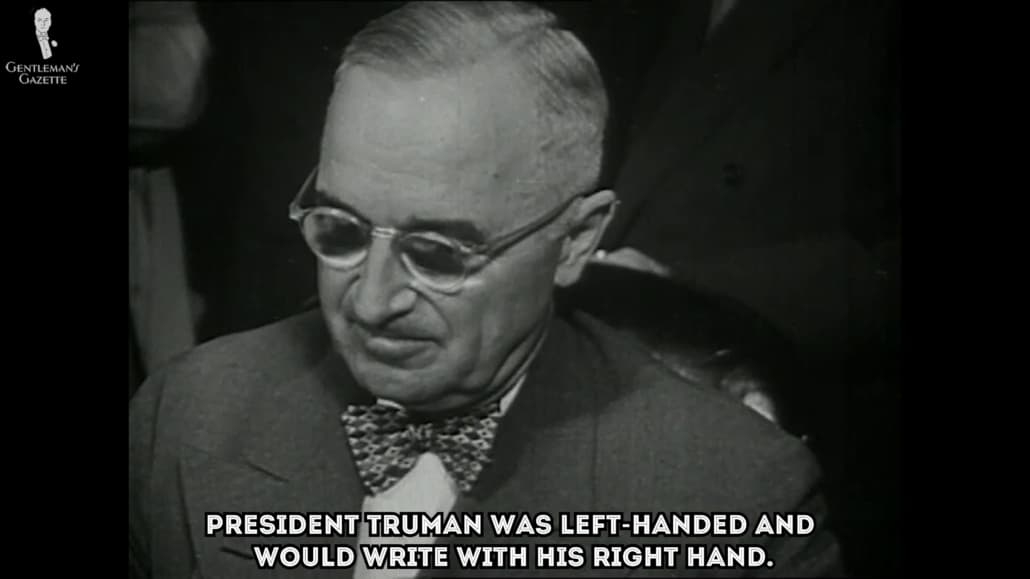
I read this article just a few months back, and had planned on getting a ream of HP Premium32. I hadn’t at the time because I didn’t have any fountain pens at the time either. However, my FP situation changed right after the first of the year. I bought a 4-pack of Jinhao 250s along with a bunch of other stuff. But a ream of that HP paper wasn’t among the purchases. What was, was a collection of Gullor ink cartridges. I already had a couple of partially-used reams of Georgia-Pacific paper, 20lb. I can’t write straight on blank paper to save my life. So I lined my own. I started with 1/4″, and that was a bit tight, even for my small writing. So I tried 3/8″, and that was a little too much. Wasted space, as far as I’m concerned. I tried splitting the difference at 5/16, and that actually works pretty well. I made a master copy to run off a few sheets at a time until I can get a document set up on my computer. All that to say this: the Gullor black and blue inks do great on that paper. No bleeding, virtually no feathering, and not enough ghosting to worry about. I’m not real concerned about the sheening and such right now, as I just staryed to use the paper to write my first drafts of my books, and a couple of letters. And since my first drafts won’t be for the general public, there’s no need for me to be too awful fancy. But I’m still going to get a ream of that Premium32. Soon, hopefully. Thanks for all the reviews and recommendations you do. Sorry this is so long.
Thanks for stopping back by to let everyone know about your experiences, David. I’ve never used Gullor ink before. Glad to hear it behaves on your GP 20lb paper! Happy writing!
I second your recommendation. HP Premium28 is a great paper for Ink or Laser Jet printing. It has a brightness that makes printed documents pop and a weight and texture that implies understated quality. It’s also a good ballpoint paper. But it’s not a very good fountain pen paper.
I bought that ream of HP Premium32 to try with my fountain pens. I liked how it worked so well that I ordered three more reams of it. That’s what I’ll be using for my manuscript first drafts. Thanks for all the info.
Affiliate Support
Pros: Extremely inexpensive, very fountain pen friendly
Cons: A little boring, quite thick
Value Rating: 3.71 Stars, Cost per A5 sheet: One of the best things about this paper is how easy it is to find and how inexpensive it is. Most office supply stores carry it, so there’s a good chance you could go out and buy some right now. It is sold by the ream, which means you get 500 sheets at a time. That’s a lot of paper! Now what do you do with that much paper? Since it’s so inexpensive, you won’t feel bad about using it for scrap paper. It is wonderful to take notes on and you can cut it into smaller pieces that you can keep around your house. It’s also nice to write letters on, but because it is so thick you’ll want to be careful about using too many sheets at once..02
Who this paper is for: Anyone who wants something better than crappy printer paper
Upgrade to this paper from: Cheap paper that isn’t fountain pen friendly
Upgrade from this paper to: Premium writing paper like that from Midori, Clairefontaine or G. Lalo.
Is there any plain 120gsm paper that is even better for fountain pens than HP Premium32? Price is not important. Doesn’t have to be exactly 120gsm, 110 to 130gsm range is also fine.
Here’s a writing sample with the same pens and inks on the Premium28 paper
If you’d like a bit more information about how I test papers and notebooks, I wrote an article about my paper rating system.

In general, if you have a big hand and big handwriting, a slightly broader nib may look more appealing. On the flip side, if you like an elegant look and you have small handwriting, an extra-fine tip may be the right one for you. In calligraphy, stub or italic nibs are very popular. Personally, I like really wide nibs for signatures because they give it a unique look that is very hard to fake. So, for signatures, I typically use an oblique 3B nib, which is a triple width and it’s very wide. I wouldn’t want to write letters with it though, because it’s uncomfortable.
Personal notes are more meaningful when written by hand with a nice fountain pen
Many regular printer papers are not really suited for fountain pen ink because as soon as you write on them, the ink bleeds and looks very bad. Instead, buy a paper that is made for fountain pens and when you write on it, it will look beautiful. The same is true for stationary if you want to write greeting cards — make sure it works with a fountain pen. A good paper doesn’t feather or run and it is often made out of cotton
Some fountain pens, however, especially smaller ones are designed to have a cap posted in the back for the perfect balance. Again, this is something you have to try out yourself and see what kind of feel you like. On vintage fountain pens, I’ve often seen a cap crack, probably because it was posted too often and too aggressively. So, personally, that’s another reason why I don’t do it. The fountain pen I use for signatures is actually in a stand on my desk and the cap is mounted to the stand so I couldn’t even have the opportunity to post a cap on it.
Writing With A Fountain Pen

One hundred years ago, fountain pen manufacturers would offer 50 different kinds of nibs including extra, extra fine, and extra broad. They also had stub nibs and oblique nibs that were slightly cut and angled just to get a different look. If you’re just starting out or if you’re a lefty, I suggest going with a fine nib or maybe a medium nib
Again, figuring out whether something is too light or too heavy, also depends a bit on your personal preference
A really important distinction of writing with a fountain pen from writing with a roller-ball or ballpoint pen is that you have to keep your hand rather rigid. What do we mean by that? Well, some people are finger writers and they move their hand and their fingers as they write. With a round ballpoint pen that is okay because it works in every angle but with a fountain pen with a straight nib, that is not the case.

Tomoe River is a Japanese paper manufacture and it’s paper is widely known for it’s silky smooth texture and extreme resistance to ink. The paper is extremely thin, coming in at only 52 g/m 2 , and are very durable. They do tend to crinkle a little if you are rough with the pages, but do not rip or tear easily.
Color: Available only as White Feathering: None, expect on ink drips and wet flex pens Bleed-through: Absolutely none Show-through: Very minimal even though the paper is not thick Texture: Extremely smooth, like writing on glass Dry Time: Long, but less than Tomoe River. Rulings: Can be found as Blank, Lined, Dot, or Graph Sizes: Can be found in full A4, A5, and pocket sized pads and notebooks Price: $14.50 for an A4 pad of 80 sheets. Availability: Pads and notebooks offered and can be found at most online retailers Amazon: Link Here
Moleskine notebooks are can be found everywhere! They are recognizable from those rotatable stands that you see in bookstores and other retailers. Often lauded as a great notebook brand, their paper works well for pencils, ball points and rollerballs. However, their paper performs terribly with fountain pens, feathering like a tissue and often bleeding through onto the second sheet. Personally, I stay as clear away from Moleskine as I can as the paper just does not work for me. Some people have found success using Extra-Fine (EF) nibs on the notebooks, but not many.
Bleed-through is very common on thinner papers or bad quality papers that tend to absorb ink very quickly. Higher-end papers generally are coated and manufactured in a way to resist ink from bleeding through, no matter how thin the paper is. However, even with the best fountain pen paper, you may get traces of your writing being visible on the other side. This is known as show-through or sometimes called “ghosting.” Show-through can be countered by using a thicker paper stock, such as 32lb over 20lb.
Price and Availability

The following papers are my personal favorites but are presented in no particular order. You can not go wrong choosing any ones of the papers on this list!
Let’s start with an overview of the things to consider when picking a paper. Click here to jump straight to the recommendations.
HP is generally known for their computers and printers, but they also make a large selection of printer and photo paper. Their “Premium Laser” line, although designed for laser printers, works absolutely wonderfully with fountain pens. The surface is coated and offered in various paper weights: 24lb, 28lb (now discontinued), and 32lb.
Clairefontaine paper is actually made by the same company that makes Rhodia paper so the paper quality is beyond superb. Like Rhodia, Clairefontaine has a large number of offerings in rulings and paper format. The paper is generally 90g/m 2 and is thicker than regular copy paper. They are renown for their Triomphe notepads as well as their bound notebooks.

Not to be confused with bleedthrough, ghosting is when the paper is so lightweight that the ink will show through the reverse, but it has not bled through. The best example being the excellent Tomoe River paper that due to its inherent lightness (52 gsm) is prone to such aesthetic quirks. For me personally, I quite like some ghosting in certain situations. With my Hobonichi Techo, the ghosting adds the interesting consequence of the ink being almost heavier than the paper. After a few months of doodling the notebook will bulge up and, for some unknown reason, I rather like this.
I see this question get thrown around a lot in various forums, and sadly, the default conception that GSM (Grams per Square Meter) is the defining factor of what makes specific papers fountain pen friendly is very much false. Yes, heavy paper tends to (generally speaking) perform better than cheap lightweight copier paper when you’re scribbling with a fountain pen, but that’s an oversimplification of a multifaceted issue. We’ll get into the specifics of this issue here.
- Rhodia Paper: 80 gsm, but a solid performer. Inexpensive (in Europe at least) and handles ink rather nicely.
- Oxford Optik Paper: This is a UK-specific option and ridiculously cheap. Much like the Rhodia options, this is also 80 gsm and I have a sneaking suspicion that it’s made by Clairefontaine (who make Rhodia paper).
- Apica Paper: 81 gsm and solid as hell
Besides a superior writing experience, high quality paper that is fountain pen friendly is milled in such a way as to minimize the amount of fibers that get stuck between the tines of your nib, which is really good, as those little clumps of fiber can really hamper your writing experience.
Bleedthrough

So, how do paper manufacturers deal with such issues? The primary method seems to be with weight, density of the fibres, and smoothness of the finish when it is milled. As unscientific as my explanation is – I think the denser the paper, the less likely it is to bleed through. The obvious exception to this being the appeal of laid or woven paper, but those are really aesthetic considerations. Some people like writing on heavily textured paper due to the feedback it produces. Same can be said with paper with a high cotton content. These considerations do not define the viability of fountain pen ink friendly paper, but rather a personal bias.
This is when the ink literally bleeds through the paper to the other side. It’s hideous and should be avoided at all costs. Generally speaking, a low GSM paper being so thin will be prone to this (some exceptions apply) due to not being able to absorb all the ink prior to reaching the reverse of the paper. Think of a newspaper vs watercolour paper stock. Doesn’t really matter on the relative quality of newspaper paper or the watercolour paper, one will always have bleed through and the other won’t by virtue of having so much highly absorbent material to eat through.
As a side note

You should always keep the cap on top of the nib when you don’t write with the fountain pen. Why? Well, if you don’t, it dries out and you’ll have a hard time actually starting to write the next time around. Also, your nib may get damaged, so unlike with a ballpoint pen, you always want to put the cap and cover your nib.
In my opinion, it’s much more elegant than using cartridges or a converter and it’s my fountain pen mechanism of choice. In the early days of fountain pens, you could also find models with a lever and an ink-sac inside or some push-button mechanisms, but none of them have stood the test of time. And today the piston, the converter, and the cartridges are basically the options you have.
When you write with a fountain pen, it’s essential that you keep it at the right angle, and that you’re not flexible with your fingers. So, what exactly does it mean? If the tip of your nib is facing down on the paper and the slit is facing up, it should have a net angle of about 45 to 55 degrees. Once with that angle, write a few words to find that “sweet spot” for you that feels comfortable writing.
Many regular printer papers are not really suited for fountain pen ink because as soon as you write on them, the ink bleeds and looks very bad. Instead, buy a paper that is made for fountain pens and when you write on it, it will look beautiful. The same is true for stationary if you want to write greeting cards — make sure it works with a fountain pen. A good paper doesn’t feather or run and it is often made out of cotton
2. Clean Your Fountain Pen Regularly

A fountain pen is a very personal instrument and it’s supposed to be perfect for your hand
In general, prices for fountain pens can range from very few dollars to thousands of dollars. To learn more about inexpensive fountain pens and mid-range fountain pens check out our guides! Now, if a fountain pen is more expensive than a ballpoint pen or a rollerball, why would you want to invest in one? Well, the connoisseur appreciates the personality added to his penmanship, and it’s just a very different writing experience.
Some people would post the cap at the back of the pen to create a different balance.
Back in the old days, people who were lefties had to actually learn how to write with their right hand because it was the “proper” way to do it. In this day and age, children learn how to write with their left hand
